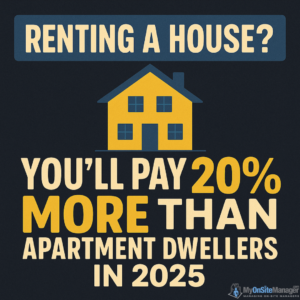The U.S. rental housing market is undergoing a seismic shift. According to a February 2025 report from Finance & Commerce, single-family home rentals now cost nearly 20% more than multifamily apartment rentals—the highest price gap ever recorded.
As affordability challenges persist for homebuyers, more families and professionals are turning to rental homes, driving up prices for standalone properties. This trend is transforming not only the rental market—but also the American housing dream.
A Historic Price Divide
Zillow’s data reveals a staggering contrast between housing types:
-
Single-family rents are up 41% since early 2020.
-
Apartment rents have increased 26% over the same timeframe.
-
The average single-family rental now costs $350 more per month than a multifamily unit.
-
In the last year alone, single-family rents grew 4.4%, compared to just 2.4% for apartments.
This means that renters seeking more space, privacy, and access to suburban school districts are paying a significant premium—even though they’re not buying homes.
What’s Fueling the Surge in Single-Family Rent Prices?
Several economic, demographic, and supply-chain factors are contributing to the widening rental gap:
1. Homeownership Remains Out of Reach
High mortgage rates—hovering around 6.5% to 7%—combined with steep home prices and inflation have sidelined many would-be buyers. This includes millennials and Gen Z professionals who, under normal market conditions, would be purchasing their first homes by now.
Instead, these would-be homeowners are opting to rent detached homes, adding pressure to an already limited supply.
🗣 “We’ve seen a big rise in people looking for space, but not ready to buy,” notes Zillow senior economist Orphe Divounguy. “They’re choosing single-family rentals instead—and the competition is driving up prices.”
2. A Supply-Demand Imbalance
Although multifamily construction is booming, single-family rental inventory has not kept pace. Many developers still focus on owner-occupied models, and homeowners with ultra-low interest rates are reluctant to sell or rent their properties.
Zillow reports that single-family rental inventory is still 25% below pre-pandemic levels, meaning more renters are fighting over fewer homes.
3. Family-Led Rental Demand
Post-pandemic lifestyle changes have altered renter preferences. Families and remote workers now prioritize private yards, home offices, and distance from dense urban living—all of which are features typically found in single-family homes.
These “quality of life” upgrades come at a cost, and renters are increasingly willing to pay it.
Regional Standouts: Where the Price Gap Is Most Extreme
The rent premium for single-family homes isn’t the same everywhere. Some cities are seeing especially dramatic gaps:
| Metro Area | Single-Family Rent Premium Over Apartments |
|---|---|
| Salt Lake City, UT | 59% more |
| Cincinnati, OH | 45% more |
| St. Louis, MO | 43% more |
| Detroit, MI | 9% more |
| Pittsburgh, PA | 14% more |
In metros like Salt Lake City and Cincinnati, demand for space—combined with constrained housing development—has pushed single-family rents well beyond affordability thresholds.
Landlords Have Leverage
Another key factor: concessions (discounts) are back for apartments—but not for houses.
Apartment managers are offering perks such as:
-
Free rent for the first month
-
Waived parking fees
-
Flexible lease terms
Meanwhile, single-family landlords have little need to compete in the same way. In hot rental markets, these homes often rent out quickly with no incentives required.
What This Means for Renters, Owners, and Property Managers
For Renters:
Renting a house now comes with a steep premium. While the privacy and square footage of a detached home can be appealing, many renters are being priced out. As a result, some are downsizing into apartments or moving to lower-cost metros.
Tip for Renters:
If you’re on a budget, consider exploring smaller cities or renting multifamily units with in-unit amenities and shared green spaces.
For Investors & Property Managers:
The numbers don’t lie—single-family rentals are proving to be high-yield assets. Investors holding these properties can benefit from higher monthly income and stable long-term tenants.
Tip for Property Managers:
Consider expanding single-family inventory or optimizing marketing for suburban and family-focused tenants. Transparency, maintenance responsiveness, and digital tenant services can boost retention in these properties.
What’s Next?
Unless there’s a major expansion in single-family construction or a drop in mortgage rates, rents for detached homes are likely to remain elevated throughout 2025.
However, with affordability reaching a breaking point in many areas, policy interventions and zoning reforms may be necessary to increase supply and ease pricing pressure.
Source
Original article: Single-family rents reach record high, 20% above apartments – Finance & Commerce, February 2025

